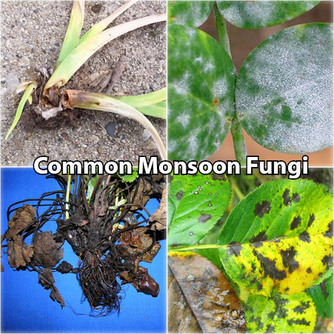Monsoon conditions are perfect for these 5 fungi.

The association between a fungus and the root of a plant date pre-historic times. For millions of years this relationship has made plants dependent on specific types of fungi for survival because of the vital role the fungi plays in the component of soil life and soil chemistry. That doesn't mean, however, that all of the fungus attaching itself to our trees and plants are beneficial. Fungus growth increases as the humidity and moisture does, which makes the Monsoon season an ideal time for them to periodically attack the healthy trees and plants throughout our landscape. Here are the top 5 most common fungus we see during the Monsoon and how to identify them. Powdery Mildew
This is the easiest of the fungi to spot as infected plants display white, powdery spots on their leaves and stems. As the plant becomes increasingly more infected the spots will become denser and appear in larger areas of the plant. This fungus thrives in the moist and moderate temperatures we experience during the Monsoon months. Although this fungus is generally harmless to most trees and plants it is important to specifically treat your citrus varieties as it can alter the taste and yields of your fruit.
Crown Rot
One of the more deadly fungus to appear on our list. Crown Rot attacks almost all fruit trees and can also attack ornamental varieties and various shrubs. Current Monsoon conditions produce warm, moist soil which allows Crown Rot to develop and thrive quickly. This disease kills trees and plants by growing from the roots, up through the root crown and into the lower trunk. Affected trees and plants appear drought stressed, experience discoloration in leaves and give off a distinct pumpkin-like odor.
Root Rot
This disease is most common in shade and ornamental trees and, much like Crown Rot, is found in moist soils around the base of the plant or trunk of the tree. Infected trees and plants will show signs of the disease through leaf coloration, browning of foliage and drooping of branches and stems.
Black Spot
Black Spot appears on the leaves of trees and plants in small, black dime-sized circles. These appear on the surface of the leaf and can cause leaves to drop from the plant. During times of high humidity (*cough Monsoon season) this disease will jump to new leaves and begin the infection cycle. Treating Black Spot can be done by clearing infected leaf debris away from the tree or plant.
Verticullum Wilt
A disease that attacks over 300 different trees and plants the Verticullum Wilt fungus often infects vegetables, fruit trees, flowers, shade and forest trees. The most common symptom is the wilting of the stem and leaves and the appearance of infection. The infection generally affects only lower or outer parts of plants or just a few branches on a tree. Because of the warm, moist air we experience during Monsoon season, Verticullum appears most often in July and August.
Although these fungi can be nasty for our trees and plants they are often preventable with proper tree and plant care and maintenance. This week we’re experiencing another Monsoon burst which means higher levels of moisture and warm temperatures. Make sure to get out in your yard and check for the above signs of potentially harmful fungus attacking your landscape. Stop in to any Moon Valley location and speak with a nursery professional for treatment and other preventative options.
**Hint: A picture is worth...well, a picture helps our pros quickly and accurately identify your problem. So, snap a picture and bring it to your nearest nursery!
Submit a Comment